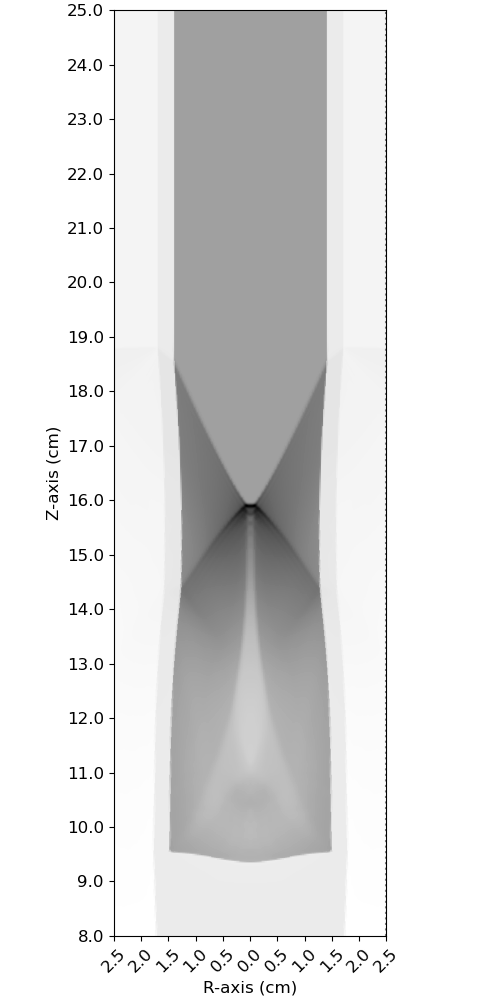Pytorch Nested Cylinder Models
Straightfoward CNNs were developed in pytorch to estimate the scaling of a Preston-Tonks-Wallace (PTW) strength model from a nested cylinder experiment.
Table of Contents:
Model Inputs & Outputs
Networks trained on nested cylinder data take as input an image showing the density throughout the experiment. An example density field is shown below.
These models predict the value that the PTW strength model was scaled by.
Running the Nested Cylinder Example
To run the scripts on the pytorch nested cylinder networks, use the following arguments:
--PACKAGE pytorch
--EXPERIMENT nestedcylinder
--MODEL ../examples/pyt_nestedcyl/trained_rho2PTW_model.pth
--INPUT_FIELD rho
--INPUT_NPZuse any .npz file in../examples/pyt_nestedcyl/data/
--INPUT_DIR ../examples/pyt_nestedcyl/data/
--DESING_FILE ../examples/pyt_nestedcyl/nestedcyl_design_file.csv
--FIXED_KEY id0643,--FIXED_KEY idx00130, or--FIXED_KEY None
Nested Cylinder Data
The file names of nested cylinder data contain multiple pieces of information about their contents. The two relevent componets are the id and the idx:
- The id is followed by a number identifying the experiment ID.
The value of
PTW_scaleis identical across files with identical id ‘s.Data is included for id0643 at all 22 timesteps.
- The idx specifies what time step the simulation was at.
The value of the
sim_timewill be identical across files with identical idx ‘s.Data is included at idx00112 for 31 differnt simulations.
Each .npz nested cylinder data file contains the following fields:
sim_time (scalar): simulation time stamp corresponding to a unique idx value
rho (2D array): density training field (use
-IN_FIELD rho)hr_outerWall, hr_bottomWall, hr_mcSide, hr_mcBottom, hr_innerCylClide, hr_innerCylBottom, hr_MOI, hr_innerCylBottom, hr_innerCylCorner, hr_innerCylRight (2D arrays): density of simulation compoments
volhr_outerWall, volhr_bottomWall, volhr_mcSide, volhr_mcBottom, volhr_innerCylSide, volhr_innerCylBottom, volhr_MOI (2D array): volume average density of similation components
pressure (2D array)
temperature (2D array)
melt_state (2D array): binary array of if a cell has melted
porosity (2D array)
eqps (2D array): equivalent plastic stress
eqps_rate (2D array): equivalent plastic stress rate
eff_stress (2D array): effective stress
bulk_mod (2D array): bulk modulus of the material
sound_speed (2D array): speed of sound in the material
rVel (2D array): veliocty of material in the R-axis direction
zVel (2D array): velocity of material in the Z-axis direction
Rcoord (1D vector): vector containing position in cm of all cells along the R-axis
Zcoord (1D vector): vector containing position in cm of all cells along the Z-axis
Model Architecture
These models consist of a single branch that passes the image input straight forward through the network.
Model Layers
The layers in model follow the following naming convention:
in???: layer near top of the network
??Conv??: 2D convolutional layer
??Norm??: 2D batch normalization layer
??Activation: GELU activation layer
interp_module.??.##: layer in “interpretability stack”
reduction_module.??.##: layer in the “reduction stack”, which reduced layer size by using a stride ≠ (1,1)
end???: layer near the end of the model
hidden: linear hidden layer
hidden#Activation: GELU activation layer after a hidden layer
linOut: linear layer that generates output
flattenLayer_##:
torch.nn.Flatten()layer

